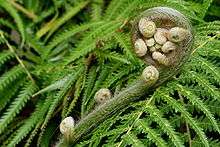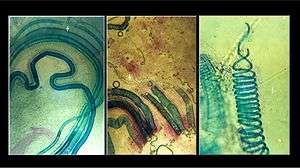Vascular plant
Vascular plants (from Latin vasculum: duct), also known as tracheophytes (from the equivalent Greek term trachea), form a large group of plants (c. 300,000 accepted known species)[5] that are defined as land plants that have lignified tissues (the xylem) for conducting water and minerals throughout the plant. They also have a specialized non-lignified tissue (the phloem) to conduct products of photosynthesis. Vascular plants include the clubmosses, horsetails, ferns, gymnosperms (including conifers) and angiosperms (flowering plants). Scientific names for the group include Tracheophyta,[6][4]:251 Tracheobionta[7] and Equisetopsida sensu lato. Some early land plants (the rhyniophytes) had less developed vascular tissue; the term eutracheophyte has been used for all other vascular plants.
| Vascular plants | |
|---|---|
 | |
| Silurian–Holocene,[1] 425–0 Ma[2] | |
| Scientific classification | |
| Kingdom: | Plantae |
| Clade: | Embryophytes |
| Clade: | Polysporangiophytes |
| Clade: | Tracheophytes Sinnott, 1935[3] ex Cavalier-Smith, 1998[4] |
| Divisions † Extinct | |
| |
Characteristics
Botanists define vascular plants by three primary characteristics:
- Vascular plants have vascular tissues which distribute resources through the plant. Two kinds of vascular tissue occur in plants: xylem and phloem. Phloem and xylem are closely associated with one another and are typically located immediately adjacent to each other in the plant. The combination of one xylem and one phloem strand adjacent to each other is known as a vascular bundle.[8] The evolution of vascular tissue in plants allowed them to evolve to larger sizes than non-vascular plants, which lack these specialized conducting tissues and are thereby restricted to relatively small sizes.
- In vascular plants, the principal generation phase is the sporophyte, which produces spores and is diploid (having two sets of chromosomes per cell). (By contrast, the principal generation phase in non-vascular plants is the gametophyte, which produces gametes and is haploid - with one set of chromosomes per cell.)
- Vascular plants have true roots, leaves, and stems, even if some groups have secondarily lost one or more of these traits.
Cavalier-Smith (1998) treated the Tracheophyta as a phylum or botanical division encompassing two of these characteristics defined by the Latin phrase "facies diploida xylem et phloem instructa" (diploid phase with xylem and phloem).[4]:251
One possible mechanism for the presumed evolution from emphasis on haploid generation to emphasis on diploid generation is the greater efficiency in spore dispersal with more complex diploid structures. Elaboration of the spore stalk enabled the production of more spores and the development of the ability to release them higher and to broadcast them farther. Such developments may include more photosynthetic area for the spore-bearing structure, the ability to grow independent roots, woody structure for support, and more branching.
Phylogeny
A proposed phylogeny of the vascular plants after Kenrick and Crane 1997[9] is as follows, with modification to the gymnosperms from Christenhusz et al. (2011a),[10] Pteridophyta from Smith et al.[11] and lycophytes and ferns by Christenhusz et al. (2011b) [12] The cladogram distinguishes the rhyniophytes from the "true" tracheophytes, the eutracheophytes.[9]
|
This phylogeny is supported by several molecular studies.[11][13][14] Other researchers state that taking fossils into account leads to different conclusions, for example that the ferns (Pteridophyta) are not monophyletic.[15]
Nutrient distribution

Water and nutrients in the form of inorganic solutes are drawn up from the soil by the roots and transported throughout the plant by the xylem. Organic compounds such as sucrose produced by photosynthesis in leaves are distributed by the phloem sieve tube elements.
The xylem consists of vessels in flowering plants and tracheids in other vascular plants, which are dead hard-walled hollow cells arranged to form files of tubes that function in water transport. A tracheid cell wall usually contains the polymer lignin. The phloem, however, consists of living cells called sieve-tube members. Between the sieve-tube members are sieve plates, which have pores to allow molecules to pass through. Sieve-tube members lack such organs as nuclei or ribosomes, but cells next to them, the companion cells, function to keep the sieve-tube members alive.
Transpiration
The most abundant compound in all plants, as in all cellular organisms, is water, which serves an important structural role and a vital role in plant metabolism. Transpiration is the main process of water movement within plant tissues. Water is constantly transpired from the plant through its stomata to the atmosphere and replaced by soil water taken up by the roots. The movement of water out of the leaf stomata creates a transpiration pull or tension in the water column in the xylem vessels or tracheids. The pull is the result of water surface tension within the cell walls of the mesophyll cells, from the surfaces of which evaporation takes place when the stomata are open. Hydrogen bonds exist between water molecules, causing them to line up; as the molecules at the top of the plant evaporate, each pulls the next one up to replace it, which in turn pulls on the next one in line. The draw of water upwards may be entirely passive and can be assisted by the movement of water into the roots via osmosis. Consequently, transpiration requires very little energy to be used by the plant. Transpiration assists the plant in absorbing nutrients from the soil as soluble salts.
Absorption
Living root cells passively absorb water in the absence of transpiration pull via osmosis creating root pressure. It is possible for there to be no evapotranspiration and therefore no pull of water towards the shoots and leaves. This is usually due to high temperatures, high humidity, darkness or drought.
Conduction
Xylem and phloem tissues are involved in the conduction processes within plants. Sugars are conducted throughout the plant in the phloem, water and other nutrients through the xylem. Conduction occurs from a source to a sink for each separate nutrient. Sugars are produced in the leaves (a source) by photosynthesis and transported to the growing shoots and roots (sinks) for use in growth, cellular respiration or storage. Minerals are absorbed in the roots (a source) and transported to the shoots to allow cell division and growth.[16]
References
- D. Edwards; Feehan, J. (1980). "Records of Cooksonia-type sporangia from late Wenlock strata in Ireland". Nature. 287 (5777): 41–42. doi:10.1038/287041a0.
- Parfrey, Laura Wegener; Lahr, Daniel J. G.; Knoll, Andrew H.; Katz, Laura A. (August 16, 2011). "Estimating the timing of early eukaryotic diversification with multigene molecular clocks". Proceedings of the National Academy of Sciences of the United States of America. 108 (33): 13624–13629. doi:10.1073/pnas.1110633108. PMC 3158185. PMID 21810989.
- Sinnott, E. W. 1935. Botany. Principles and Problems, 3d edition. McGraw-Hill, New York.
- Cavalier-Smith, T. (1998), "A revised six-kingdom system of life" (PDF), Biological Reviews of the Cambridge Philosophical Society, 73 (3): 203–266, doi:10.1111/j.1469-185X.1998.tb00030.x, PMID 9809012
- Christenhusz, M. J. M. & Byng, J. W. (2016). "The number of known plants species in the world and its annual increase". Phytotaxa. 261 (3): 201–217. doi:10.11646/phytotaxa.261.3.1.
- Abercrombie, Hickman & Johnson. 1966. A Dictionary of Biology. (Penguin Books)
- "ITIS Standard Report Page: Tracheobionta". Retrieved September 20, 2013.
- https://basicbiology.net/plants/physiology/xylem-phloem
- Kenrick, Paul; Crane, Peter R. (1997). The Origin and Early Diversification of Land Plants: A Cladistic Study. Washington, D.C.: Smithsonian Institution Press. ISBN 1-56098-730-8.
- Christenhusz, Maarten J. M.; Reveal, James L.; Farjon, Aljos; Gardner, Martin F.; Mill, R.R.; Chase, Mark W. (2011). "A new classification and linear sequence of extant gymnosperms" (PDF). Phytotaxa. 19: 55–70. doi:10.11646/phytotaxa.19.1.3.
- Smith, Alan R.; Pryer, Kathleen M.; Schuettpelz, E.; Korall, P.; Schneider, H.; Wolf, Paul G. (2006). "A classification for extant ferns" (PDF). Taxon. 55 (3): 705–731. doi:10.2307/25065646. JSTOR 25065646.
- Christenhusz, Maarten J. M.; Zhang, Xian-Chun; Schneider, Harald (2011). "A linear sequence of extant families and genera of lycophytes and ferns" (PDF). Phytotaxa. 19: 7–54. doi:10.11646/phytotaxa.19.1.2.
- Pryer, K. M.; Schneider, H.; Smith, AR; Cranfill, R; Wolf, PG; Hunt, JS; Sipes, SD (2001). "Horsetails and ferns are a monophyletic group and the closest living relatives to seed plants". Nature. 409 (6820): 618–22. doi:10.1038/35054555. PMID 11214320.
- Pryer, K. M.; Schuettpelz, E.; Wolf, P. G.; Schneider, H.; Smith, A. R.; Cranfill, R. (2004). "Phylogeny and evolution of ferns (monilophytes) with a focus on the early leptosporangiate divergences". American Journal of Botany. 91 (10): 1582–1598. doi:10.3732/ajb.91.10.1582. PMID 21652310.
- Rothwell, G.W. & Nixon, K.C. (2006). "How Does the Inclusion of Fossil Data Change Our Conclusions about the Phylogenetic History of Euphyllophytes?". International Journal of Plant Sciences. 167 (3): 737–749. doi:10.1086/503298.
- Chapters 5, 6 and 10 Taiz and Zeiger Plant Physiology 3rd Edition SINAUER 2002
Bibliography
- Cracraft, Joel; Donoghue, Michael J., eds. (2004). Assembling the Tree of Life. Oxford University Press. ISBN 978-0-19-972960-9.CS1 maint: ref=harv (link)
- Cantino, Philip D.; Doyle, James A.; Graham, Sean W.; Judd, Walter S.; Olmstead, Richard G.; Soltis, Douglas E.; Soltis, Pamela S.; Donoghue, Michael J. (1 August 2007). "Towards a Phylogenetic Nomenclature of Tracheophyta". Taxon. 56 (3): 822. doi:10.2307/25065865. JSTOR 25065865.
- Kenrick, P. (29 June 2000). "The relationships of vascular plants". Philosophical Transactions of the Royal Society B: Biological Sciences. 355 (1398): 847–855. doi:10.1098/rstb.2000.0619. PMC 1692788. PMID 10905613.
- Pryer, Kathleen M.; Schneider, Harald; Magallon, Susana. The radiation of vascular plants (PDF). pp. 138–153., in Cracraft & Donoghue (2004)